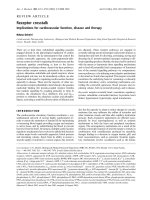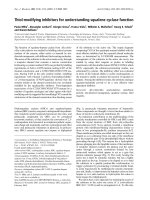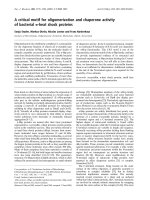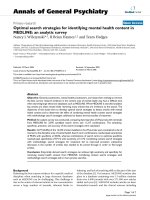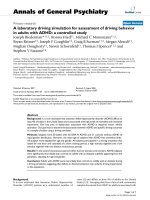Báo cáo y học: "Enoxaparin, effective dosage for intensive care patients: double-blinded, randomised clinical trial" potx
Bạn đang xem bản rút gọn của tài liệu. Xem và tải ngay bản đầy đủ của tài liệu tại đây (436.2 KB, 7 trang )
RESEARC H Open Access
Enoxaparin, effective dosage for intensive care
patients: double-blinded, randomised clinical trial
Sian Robinson
1*
, Aleksander Zincuk
1
, Thomas Strøm
1
, Torben Bjerregaard Larsen
2
, Bjarne Rasmussen
2
, Palle Toft
1
Abstract
Introduction: Intensive care unit (ICU) patients are predisposed to thromboembolism. Routine prophylactic
anticoagulation is widely recommended. Low-mo lecular-weight heparins, such as enoxaparin, are increasingly used
because of predictable pharmacokinetics. This study aims to determine the subcutaneous (SC) dose of eno xaparin
that would give the best anti-factor Xa levels in ICU patients.
Methods: The 72 patients admitted to a mixed ICU at Odense University Hospital (OUH) in Denmark were
randomised into four groups to receive 40, 50, 60, or 70 mg SC enoxaparin for a period of 24 hours. Anti-factor Xa
activity (aFXa) was measured before, and at 4, 12, and 24 hours after administration. An AFXa level between 0.1 to
0.3 IU/ml was considered evidence of effective antithrombotic activity.
Results: Median peak (4 hours after administration), aFXa levels increased significantly with an increase in
enoxaparin dose, from 0.13 IU/ml at 40 mg, to 0.14 IU/ml at 50 mg, 0.27 IU/ml at 60 mg, and 0.29 IU/ml at 70 mg
(P = 0.002). At 12 hours after administr ation, median aFXa levels were still within therapeutic range for those
patients who received 60 mg (P = 0.02).
Conclusions: Our study confirmed that a standard dose of 40 mg enoxaparin yielded subtherapeutic levels of
aFXa in critically ill patients. Higher doses resulted in better peak aFXa levels, with a ceiling effect observed at
60 mg. The present study seems to suggest inadequate dosage as one of the possible mechanisms for the higher
failure rate of enoxaparin in ICU patients.
Trial Registration: ISRCTN03037804
Introduction
Geerts et al. [1] determined the prevalence of deep vein
thrombosis (DVT) in intensive care unit (ICU) patients
not rece iving prophylaxis to be in the range of 10-80%.
The critically ill patient is especi ally predisposed to
thromboembolism, possessing many inherent risk fac-
tors: cardiac failure, trauma, sepsis, ca ncer, increasing
age, and obesity [1-5]. The acquisition of others, for
example: respiratory support with decreased mobility
and invasive monitoring, further tips t he scale in favor
of thrombosis during the ICU stay. Thus, these patients
should undergo routine assessment for venous throm-
boembolism (VTE). The use of routine thromboprophy-
laxis will probably be justified in most [1,2].
Discerning DVT in critically ill patients is difficult [6].
The history and physical examination are often of little
use, and thus, these patients are vulnerable to a delay in
diagnosis. Low-molecular-weight heparins (LMWHs) are
often used as a safe and effective means of prophylaxis
[7-9] against VTE in medical and surgical patients.
However, the efficacy of LMWHs in critically ill patients
is less certain [10].
The antithrombotic activity of LMWHs is often deter-
mined by aFXa assay, despite several studies finding no
direct correlation between aFXa activity and clinical out-
come. Mayr [11] concluded that the European standard
daily dose of 40 mg enoxaparin [ 12] was ineffective in
ICU patients to achieve the recommended, albeit unpro-
ven, aFXa levels of 0.1 to 0.3 IU/ml. Thus, existing
guidelines in other patient populations should not be
directly appli ed to critical care patients without further
study [2].
* Correspondence:
1
Department of Anaesthesia and Intensive Care, Odense University Hospital
(OUH), Sdr. Boulevard 29. Odense C, DK 5000, Denmark
Robinson et al. Critical Care 2010, 14:R41
/>© 2010 Robinson et al.; licensee BioMed Central Ltd. This is an open access article distributed under the terms of the Creative
Commons Attribution License ( which permits unrestricted use, distribution, and
reproduction in any medium, provided the original work is properly cited.
Most intensive care physicians widely acknowledge the
need for evidence-based guidelines for antithromboem-
bolic prophylaxis in this patient population and lament
the d earth of research on VTE in critical care patients
[4]. This study aims to establish the optimal dose of
enoxaparin for ICU patients.
Materials and methods
Study population
The sample population consisted of 72 consecutive
patients admitted to the ICU who were ≥ 18 years of
age, with a minimum stay of >24 hours. Patients weigh-
ing <50 kg or >90 kg w ere excluded. Likewise, patients
with bleeding diathesis, those in need of an operation
within the time frame of the study, pregnant patients,
and patients requiring continuous veno-venous hemofil-
tration were deemed ineligible. We recorded patient
demographics such as age, sex, weight, height, and body
mass index (BMI). The diagnosis on admission was also
noted, and patients were classified according to standard
ICU severity-of-illness scoring systems (APACHE II,
Acute Physiology and Chronic Health Evaluation, and
SAPS II, Simplified Acute Physiology Score) on the day
of entry into the study.
Study design
A prospective randomised double-blinded study was
conducted at an 18-bed tertia ry medicosurgical ICU.
The patients were randomized into four groups/arms by
sequentially numbered, sealed envelope s to receive one
of the following SC doses of enoxaparin: 40, 50, 60, or
70 mg for a period of 24 hours. Patients, investigators,
and all other personnel involved in the conduct of the
study were blinded to individual treatment assignments.
Attending physicians received envelopes with the
assigned doses, which they then prescribed. The test
doses were dispensed by the nurses. Attending physi-
cians and nurses were therefore not blinded.
On the day of the study, blood samples were drawn
from indwelling catheters immediately b efore, and at 4,
12, and 24 hours after the administration of enoxapari n
to determine anti-factor Xa (aFXa) activity, antithrombin
(AT), prothrombin time (PT), activated partial thrombo-
plastin time (aPTT), thrombin-antithrombin complexes
(TAT), fibrinogen, platelets, and D-dimer. Serum creati-
nine, as well as creatinine clearance, was de termined for
each patient. Patients were considered nonresponders if
they showed no change in anti-factor X a levels from
baseline after administration of enoxaparin.
The study was performed in accordance with ethical
principles set forth in the Declaration of Helsinki and
with local regulations. The Committee for Good Clinical
Practice at OUH app roved and monitored the st udy.
Written informed consent was obtained from each
patient where possible, or otherwise from the closest
family member.
The funding sources for this research had no role in
the design, data collection, analysis, interpretation, or
reporting of this study.
Medication
Enoxaparin (Klexane; Sanofi-A ventis Denmark A/S,
Hørsholm, Denmark) was available as prefilled single-
dose syringes containing 20 mg and 40 mg. Nurses were
instructed to titrate the dosage carefully to avoid
inaccuracies.
Assay methods
Samples for aFXa activity of heparin in plasma and TAT
were stored at -80°C before analysis, whereas samples
for all other hemostatic parameters were analyzed within
2 hours of collection. The frozen plasma samples were
thawed and assa yed in batche s. Levels of aFXa activity
were determined by using a validated chromogenic assay
kit (COAMATIC Heparin; Chromogenix, Instrumenta-
tion Laboratory Company, Lexington, KE, USA) with
the substrate S-2732, and the apparatus (STA-R Evolu-
tion; Diagnostica Stago, Asni ères, France). The TAT
comp lexe s were determined by using an enzyme-immu-
noassay (Enzygno st TAT micro; Siemens, Marburg,
Germany).
Outcome measures
The primary end point was peak anti-factor Xa levels.
Secondary outcomes included AT, PT, aPTT, TAT,
fibrinogen, platelets, and D-dimer.
Statistical analysis
We calculated that 80 patients would be needed to detect
an absolute difference of 30% in anti-factor Xa levels 4
hours after enoxaparin administration between the groups,
assuming a power of 80% and a significance level o f 5%.
Statistical tests were two-sided and performed by using a
significance level of 5%. A database was maintained in
Microsoft Excel. The ICU patients were enrolled in the
study between February 2006 and March 2009. The Con-
sort diagram [13] shows patient disposition. (Figure 1).
Patient characteristics
Thirty-two patients were admitted with pneumonia,
exacerbation of chronic obstructive pulmonary disease
(COPD), or other respiratory complaints. The next largest
medical patient group, compris ing 15 patients, consisted
entirely of septic patients with or without the presence of
shock. Among the surgical patients were nine admitted
with ileus or other intestinal complaints, five with pancrea-
titis or infections in the biliary tree, and five with multiple
trauma. At baseline, age, APACHE II score, BMI, and
Robinson et al. Critical Care 2010, 14:R41
/>Page 2 of 7
creatinine clearance did not differ significantly between
the control group (the group receiving 40 mg enoxaparin),
and the three test groups. SAPS II scores, however, were
significantly lower in the group receiving 70 mg enoxa-
parin. All demographic data have been tabulated (Table 1).
Primary results
A strong positive correlation was found between the
dose of enoxaparin and aFXa activity levels. Median
peak (4 hours after administration) aFXa levels increased
significantly with an i ncrease in enoxaparin dose, from
0.13 IU/ml at 40 mg, to 0.14 IU/ml at 50 mg, 0.27 IU/
ml at 60 mg, and 0.29 IU/ml at 70 mg (P = 0.002).
Thegroupreceiving40mghadthehighestnumber
of non-responders (n = 5). The group receiving 70 mg
had the highest number of patients with aFXa levels
>0.3 IU/ml (n = 7). There was some variability in anti-
factor Xa levels within the same dose group. For a
dose of 40 mg enoxaparin, subtherapeutic levels
occurred in 28% at 4 hours, 67% at 12 hours, and 83%
at 24 hours. For a dose of 60 mg enoxaparin, subthera-
peutic levels occurred in 5% at 4 hours, 30% at 12
hours, and 90% at 24 hours. At 12 hours after admin-
istration, median aFXa levels were still within therapeu-
tic range for patients who received 60 mg (P = 0.02)
(Figures 2 and 3).
Secondary results
No significant difference was found in the PT, aPTT,
AT, platelet count, fibrinogen, TAT complexes, or
Table 1 Clinical characteristics of the study population
Enoxaparin dose 40 mg
(n = 18)
50 mg
(n = 16)
60 mg
(n = 20)
70 mg
(n = 18)
p
Gender (m:f) 11:7 8:8 12:8 11:7 0.9
Age (years) 63 (57-71) 65 (55-75) 63 (55-70) 70 (46-74) 0.9
BMI (kg/m
2
) 26 (24-28) 24 (21-27) 26 (23-27) 25 (22-29) 0.5
SAPS II 37 (26-40) 38 (29-51) 38 (30-43) 29 (21-35) 0.04*
APACHE II 12 (9-15) 16 (11-19) 13 (9-15) 8 (6-15) 0.1
Medical:Surgical 13:5 11:5 16:4 11:7
Creatinine clearance (ml/min) 82 (48-104) 58 (36-103) 65 (40-114) 57 (40-119) 0.8
BMI, Body Mass Index; SAPS II, Simplified Acute Physiology Score II; APACHE II, Acute Physiology and Chronic Health Evaluation. Data are expressed as median
(25-75 percentiles) or number.
Figure 1 Consort diagram.
Robinson et al. Critical Care 2010, 14:R41
/>Page 3 of 7
D-dimer levels between the four groups. No significant
change from baseline was noted in these coagulation
parameters within each group over the 24-hour study
period (Table 2). We conducted a multiple regression
analysis to determine whether crea tinine clearance,
BMI, age, or organ-failure scores had any influence on
the levels of anti-factor Xa. No such influence was
found.
Adverse events
One minor nosebleed occurred in a patient with low plate-
let count (<65 × 10
9
/L) given 50 mg enoxaparin. A single
Figure 3 Variation in anti-factor Xa over time for each dose of enoxaparin. AFXa denotes anti-factor Xa.
Figure 2 Scatter diagram depicting anti-factor Xa levels for each dose, 4 hours after enoxaparin administration. AFXa denotes anti-
factor Xa.
Robinson et al. Critical Care 2010, 14:R41
/>Page 4 of 7
death occurred in each of the 40 mg, 50 mg, and 60 mg
groups. These patients did not die with/of bleeding.
Discussion
Effectivity of enoxaparin is measured by aFXa activity.
Peak concentration of aFXa activity occurs at 3 to 4
hours after SC enoxapar in injection [12,14]. AFXa activ-
ity levels between 0.1 and 0.3 IU/ml are considered to
represent effective antithrombotic activity [11,15].
European standard dose of 40 mg enoxaparin SC,
once daily, is often used as VTE prophylaxis in critical
care patients [12]. Priglinger and Mayr et al. [10,11]
demonstrated low effectiveness of this standard in
achieving the recommended anticoagulant aFXa levels.
This study concurs with the finding that 40 mg yielded
subtherapeutic levels of aFXa in critically ill patients.
The reasons for this apparent heparin resistance/failure
are intriguing, and not entirely clear. Some authors sug-
gest that physiologic mechanisms, or pharmacologic
agents, for example, vasopressors, impair absorption of
SC heparin through adrenergic-mediated vasoconstric-
tion of peripheral blood vessels [11,14,16,17]. Others
theorized that the presence of SC edema may decrease
heparin absorption. However, no differences in aFXa
activity after SC injection of 2,500 IU dalteparin for
VTE prophylaxis betw een ICU patients with and with-
out edema have been found [18]. Still others maintain
thatthepresenceofmultipleorgandysfunctioninICU
patients may alter d rug metabolism, distribution, and
binding to albumin and acute-phase proteins [11].
We included 80 patients in the trial (the same number
of patients as the trial conducted by Mayr et al.); eight
were transferred before they could participate. The
remaining 72 patients were randomized and treated
according to the intent-to-treat principle. We found a
positive correlation between the dose of enoxap arin and
aFXa levels ≤ 60 mg. Some variability in anti-factor Xa
levels was found within the same dose group, suggesting
awidedispersionaroundthemean.Inthestudyof
Mayr et al. [11], ICU patients received 40 mg enoxa-
parin. Subsequent aFXa concentration s were below the
therapeutic level in 27% of patients at 4 hours, 58% at
12 hours, and 88% at 24 hours. Those results reflect the
findings in our study, in which, for those patients who
received 40 mg enoxaparin, subtherapeutic levels
occurred in 28% at 4 hours, 67% at 12 hours, and 83%
at 24 hours. For a dose of 60 mg enoxaparin, subthera-
peutic levels occurred in 5% at 4 hours, 30% at 12
hours, and 90% at 24 hours. A ceiling effect was
observed at 60 mg, above which the potential for bleed-
ing complications was introduce d. Further clinical trials
using 60 mg daily, with clinical end points, are needed.
No significant change from baseline occurred in aPTT,
PT, AT, platelet count, D-dimer, and fibrinogen levels,
irrespective of the dose of enoxaparin. These findings
are consistent with other studies, which found no
change in these hemostatic parameters with LMWH use
[10,11]. TAT serves as an indicator of thrombin produc-
tion and reflects the activation of coagulation. As enoxa-
parin moderates the conversion of prothrombin to
thrombin, TAT levels might be expected to decrease
with enoxapa rin use [19,20]. In our study, a nonsignifi-
cant trend toward decreased TAT lev els with increasing
dose of enoxaparin was observed.
Mayr et al. [ 11] showed a significant negative correla-
tion between aFXa levels and multiple organ dysfunc-
tion. Judging from the APACHE II score, the study
patients all appear to be moderately to severely ill. The
finding that patients w ho received 70 mg had lower
SAPS II scores was unexpected, as the study was rando-
mized; however, comparison of multiple parameters will
invariably lead to one such parameter attaining signifi-
cance purely by chance.
Periodic monitoring of aFXa levels is recommended in
special populations (for example, in pregnant patients,
children, patients with acute kidney injury (AKI), or in
those at extremes of body weight [21]. The aFXa activity
3 hours after enoxaparin had a negative correlation with
BMI [10], owing to reduced blood flow in fat tissues,
resulting in decreased drug absorption [11], and thus
obese patients were not included. Standard therapeutic-
dose enoxaparin in patients with severe AKI led to
Table 2 Other coagulation parameters at baseline
Parameter Enoxaparin
40 mg
Enoxaparin
50 mg
Enoxaparin
60 mg
Enoxaparin
70 mg
p
TAT (μg/L) 8 (6-16) 10 (5-15) 13 (7-25) 11 (6-19) 0.5
aPTT (seconds) 41 (36-49) 44 (36-47) 40 (37-46) 43 (39-49) 0.9
PT (%) 73 (43-81) 73 (56-82) 60 (54-88) 67 (52-77) 1.0
Platelets (×10
9
/L) 211 (147-356) 220 (165-278) 201 (137-283) 299 (200-394) 0.4
AT (%) 77 (48-99) 72 (40-109) 72 (45-105) 82 (65-99) 0.9
Fibrinogen (μmol/L) 15 (13-18) 16 (12-18) 16 (13-19) 15 (11-21) 1.0
Ddimer (mg/L) 2 (2-5) 4 (2-5) 3 (2-4) 3 (2-5) 0.5
Data are expressed as median (25th-75th percentiles) or number.
Robinson et al. Critical Care 2010, 14:R41
/>Page 5 of 7
accumulation, resulting in higher aFXa l evels and a con-
current increased risk of bleeding complications [21,22].
Many advocate avoiding the use of LMWHs or using a
lower dose of these agents combined with careful moni-
toring of drug levels and anticoagulant effects [1,23].
From the median creatinine clearance in Table 1, it is
easily inferred that study patients had renal functions
that ranged from being normal to only moderately
impaired. This was done to prevent AKI from influencing
the anticoagulant effect of the different enoxaparin doses.
One clear limitation of our study was that it was not
designed to detect VTE. The patients had a drug expo-
sure of only 24 hours and were not screened for VTE
by using Doppler ultrasound. I n addition, the nurses
found it somewhat difficult to titrate such small doses
of enoxaparin, and this may have resulted in the varia-
bility in anti-factor Xa levels seen within the same
dose group. Despite this, the present study is both
timely and relevant to issues facing intensive care phy-
sicians. The inclusion of 72 patients is quite good for a
project of this nature, and the study was powered to
80%. In addition, our study generates the hypothesis of
inadequate dosage being one of the possible mechan-
isms for the higher failure rate of enoxaparin in ICU
patients.
Our findings cannot be extrapolated to mean that ICU
patients receiving 60 mg are better protected than are
those receiving a standard dose of 40 mg, as aF Xa activ-
ity is only a surrogate parameter.
Most studies suggest that although aFXa activity can-
not be directly related to clinical outcome [7,20,24,25],
lower concentrations seem to result in less-effective pre-
vention of VTE. One study has even demonstrated a sta-
tistically significant relation between aFXa levels and
wound hemat oma and thrombosis, with regression ana-
lysis suggesting that aFXa levels are predictive of out-
come [15]. It remains to be established whether these
results o btained with enoxaparin can be generalized to
other LMWHs.
Conclusions
Our study confirms that the standard dose of 40 mg
enoxaparin yielded subtherapeutic levels of aFX a in cri-
tically ill patients. In the present study, 60 mg, o r 1.5
times the standard dose, resulted in the b est peak aFXa
levels. The study seems to suggest inadequate dosage as
oneofthepossiblemechanismsforthehigherfailure
rate of enoxaparin in ICU patients. Further trials using
60 mg daily, with clinical end points, are needed.
Key messages
• The present study seems to suggest inadequate
dosage as one of the possible mechanisms for the
high failure rate of enoxaparin in ICU patients.
• 60 mg, or 1.5 times the standard dose, resulted in
the best peak aFXa levels.
• Further trials using 60 mg daily, with clinical end
points, are needed.
Acknowledgements
Funding was provided through generous grants received from Professor,
Consultant Sophus H. Johansen’s Foundation, Danielsen’s Foundation, and
The Danish Society of Anaesthesiology and Intensive Medicine’s research
initiative. The authors are also indebted to the nursing staff of the Odense
University Hospital ICU for their invaluable assistance throughout the project.
Author details
1
Department of Anaesthesia and Intensive Care, Odense University Hospital
(OUH), Sdr. Boulevard 29. Odense C, DK 5000, Denmark.
2
Department of
Biochemistry, Pharmacology & Genetics and Centre for Thrombosis and
Haemostasis, OUH, Sdr. Boulevard 29. Odense C, DK 5000, Denmark.
Authors’ contributions
PT conceived the research, included patients, reviewed the manuscript, and
was responsible for the project’s economy. SR included and followed up
patients, interpreted the results, drafted the manuscript, and presented at
conferences. AZ included and followed up patients and reviewed the
manuscript. TS performed the statistical analysis and reviewed the
manuscript. TBL participated in the design of the study and reviewed the
manuscript. BR carried out the immunoassays. All authors read and
approved the final manuscript.
Competing interests
The authors declare that they have no competing interests.
Received: 25 October 2009 Revised: 4 January 2010
Accepted: 18 March 2010 Published: 18 March 2010
References
1. Geerts WH, Bergqvist D, Pineo GF, Heit JA, Samama CM, Lassen MR,
Colwell CW, American College of Chest Physicians: Prevention of venous
thromboembolism: American College of Chest Physicians Evidence-
Based Clinical Practice Guidelines. Chest , 8 2008, 133:381S-453S.
2. Geerts W, Selby R: Prevention of venous thromboembolism in the ICU.
Chest 2003, 124:357S-363S.
3. Attia J, Ray JG, Cook DJ, Douketis J, Ginsberg JS, Geerts WH: Deep vein
thrombosis and its prevention in critically ill adults. Arch Intern Med 2001,
161:1268-1279.
4. Leizorovicz A, Mismetti P: Preventing venous thromboembolism in
medical patients. Circulation 2004, 110:IV13-IV19.
5. Cook D, Douketis J, Meade M, Guyatt G, Zytaruk N, Granton J, Skrobik Y,
Albert M, Fowler R, Hebert P, Pagliarello G, Friedrich J, Freitag A, Karachi T,
Rabbat C, Heels-Ansdell D, Geerts W, Crowther M, Canadian Critical Care
Trials Group: Venous thromboembolism and bleeding in critically ill
patients with severe renal insufficiency receiving dalteparin
thromboprophylaxis: prevalence, incidence and risk factors. Crit Care
2008, 12:R32.
6. Crowther MA, Cook DJ, Griffith LE, Devereaux PJ, Rabbat CC, Clarke FJ,
Hoad N, McDonald E, Meade MO, Guyatt GH, Geerts WH, Wells PS: Deep
venous thrombosis: clinically silent in the intensive care unit. J Crit Care
2005, 20:334-340.
7. Hirsh J, Raschke R: Heparin and low-molecular-weight heparin: the
Seventh ACCP Conference on Antithrombotic and Thrombolytic
Therapy. Chest 2004, 126:188S-203S.
8. Belt van Den AG, Prins MH, Lensing AW, Castro AA, Clark OA, Atallah AN,
Burihan E: Fixed dose subcutaneous low molecular weight heparins
versus adjusted dose unfractionated heparin for venous
thromboembolism. Cochrane Database Syst Rev 2000, CD001100.
9. Samama MM, Cohen AT, Darmon JY, Desjardins L, Eldor A, Janbon C,
Leizorovicz A, Nguyen H, Olsson CG, Turpie AG, Weisslinger N: A
comparison of enoxaparin with placebo for the prevention of venous
thromboembolism in acutely ill medical patients: Prophylaxis in Medical
Patients with Enoxaparin Study Group. N Engl J Med 1999, 341:793-800.
Robinson et al. Critical Care 2010, 14:R41
/>Page 6 of 7
10. Priglinger U, Delle Karth G, Geppert A, Joukhadar C, Graf S, Berger R,
Hülsmann M, Spitzauer S, Pabinger I, Heinz G: Prophylactic anticoagulation
with enoxaparin: is the subcutaneous route appropriate in the critically
ill?. Crit Care Med 2003, 31:1405-1409.
11. Mayr AJ, Dünser M, Jochberger S, Fries D, Klingler A, Joannidis M,
Hasibeder W, Schobersberger W: Antifactor Xa activity in intensive care
patients receiving thromboembolic prophylaxis with standard doses of
enoxaparin. Thromb Res 2002, 105:201-204.
12. Horlocker TT, Heit JA: Low molecular weight heparin: biochemistry,
pharmacology, perioperative prophylaxis regimens, and guidelines for
regional anesthetic management. Anesth Analg 1997, 85:874-885.
13. Moher D, Schulz KF, Altman DG: The CONSORT statement: revised
recommendations for improving the quality of reports of parallel-group
randomised trials. Lancet 2001, 357:1191-1194.
14. Dörffler-Melly J, de Jonge E, Pont AC, Meijers J, Vroom MB, Büller HR,
Levi M: Bioavailability of subcutaneous low-molecular-weight heparin to
patients on vasopressors. Lancet 2002, 359:849-850.
15. Levine MN, Planes A, Hirsh J, Goodyear M, Vochelle N, Gent M: The
relationship between anti-factor Xa level and clinical outcome in
patients receiving enoxaparin low molecular weight heparin to prevent
deep vein thrombosis after hip replacement. Thromb Haemost 1989,
62:940-944.
16. Cook D, Crowther M, Meade M, Rabbat C, Griffith L, Schiff D, Geerts W,
Guyatt G: Deep venous thrombosis in medical-surgical critically ill
patients: prevalence, incidence, and risk factors. Crit Care Med 2005,
33:1565-1571.
17. Rabbat CG, Cook DJ, Crowther MA, McDonald E, Clarke F, Meade MO,
Lee KA, Cook RJ: Dalteparin thromboprophylaxis for critically ill medical-
surgical patients with renal insufficiency. J Crit Care 2005, 20:357-363.
18. Rommers MK, Lely Van der N, Egberts TC, Bemt van den PM: Anti-Xa
activity after subcutaneous administration of dalteparin in ICU patients
with and without subcutaneous oedema: a pilot study. Crit Care 2006, 10:
R93.
19. Sassa H, Sone T, Tsuboi H, Kondo J, Yabashi T: Diagnostic significance of
thrombin-antithrombin III complex (TAT) and D-dimer in patients with
deep venous thrombosis. Jpn Circ J 1996, 60:201-206.
20. Ofosu FA, Levine M, Craven S, Dewar L, Shafai S, Blajchman MA:
Prophylactically equivalent doses of enoxaparin and unfractionated
heparin inhibit in vivo coagulation to the same extent. Br J Haematol
1992, 82:400-405.
21. Duplaga BA, Rivers CW, Nutescu E: Dosing and monitoring of low-
molecular-weight heparins in special populations. Pharmacotherapy 2001,
21:218-234.
22. Lim W, Dentali F, Eikelboom JW, Crowther MA: Meta-analysis: low-
molecular-weight heparin and bleeding in patients with severe renal
insufficiency. Ann Intern Med 2006, 144:673-684.
23. Ginsberg JA, Crowther MA, White RH, Ortel TL: Anticoagulation therapy.
Hematology Am Soc Hematol Educ Program
2001, 339-357.
24. Brophy DF, Carr ME Jr, Martin EJ, Venitz J, Gehr TW: The pharmacokinetics
of enoxaparin do not correlate with its pharmacodynamic effect in
patients receiving dialysis therapies. J Clin Pharmacol 2006, 46:887-894.
25. Bara L, Planes A, Samama MM: Occurrence of thrombosis and
haemorrhage, relationship with anti-Xa, anti-IIa activities, and D-dimer
plasma levels in patients receiving a low molecular weight heparin,
enoxaparin or tinzaparin, to prevent deep vein thrombosis after hip
surgery. Br J Haematol 1999, 104:230-240.
doi:10.1186/cc8924
Cite this article as: Robinson et al.: Enoxaparin, effective dosage for
intensive care patients: double-blinded, randomised clinical trial. Critical
Care 2010 14:R41.
Submit your next manuscript to BioMed Central
and take full advantage of:
• Convenient online submission
• Thorough peer review
• No space constraints or color figure charges
• Immediate publication on acceptance
• Inclusion in PubMed, CAS, Scopus and Google Scholar
• Research which is freely available for redistribution
Submit your manuscript at
www.biomedcentral.com/submit
Robinson et al. Critical Care 2010, 14:R41
/>Page 7 of 7

